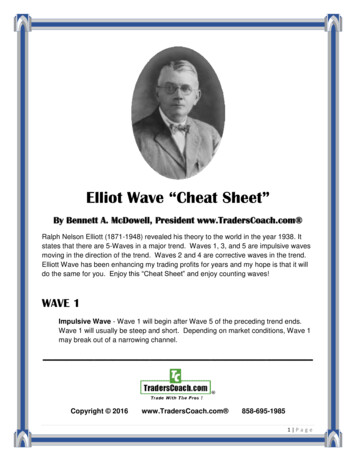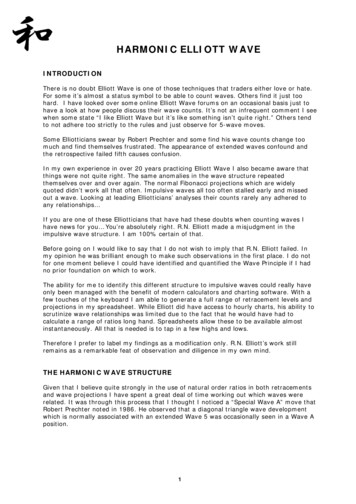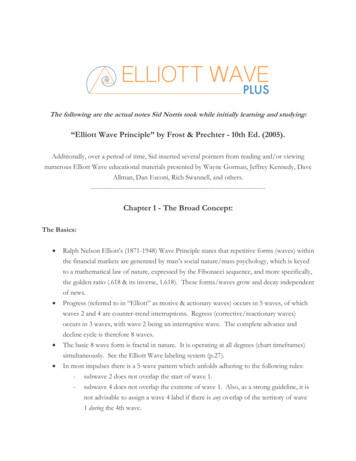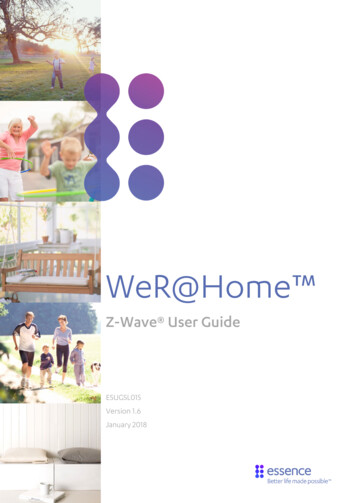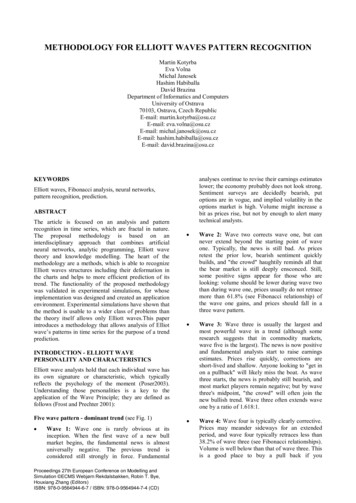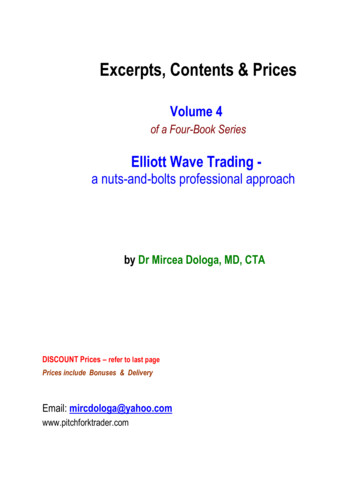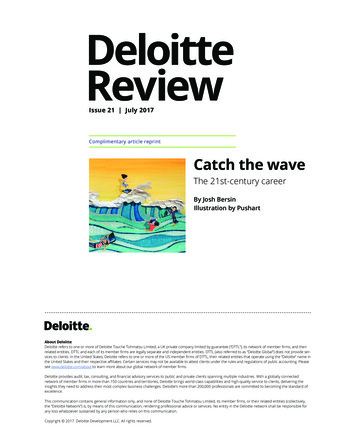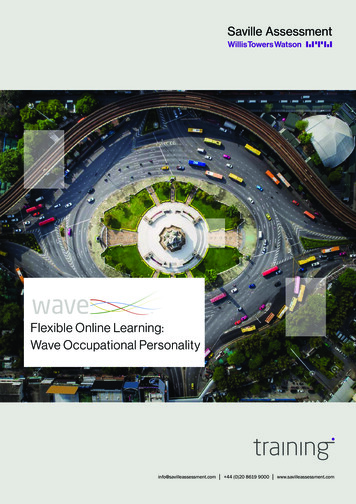
Transcription
Flexible Online Learning:Wave Occupational Personalityinfo@savilleassessment.com 44 (0)20 8619 9000 www.savilleassessment.com
IntroductionThis guide covers the content included in the SavilleAssessment Wave Occupational Personality FlexibleOnline Learning course and can be used as referencematerial during and after the training.
Contents1 Wave Distance LearningWhat is Personality?3Implicit vs. Explicit3Important Figures in Personality Theory3Applying Personality to the Workplace6Trait vs. Type6Trait Approach6Type Approach6Trait and State Measurement8Motivation8The Big Five9Competencies10The Influence of Nature and Nurture10Personality Assessment and Fairness11Assessment Methods11Bias and Fair Assessment15Introducing Wave Styles16Professional Styles16Focus Styles16Why Wave Styles?16Personality Assessment Construction17Extensive Coverage of Work Behaviors17Wave Professional Styles Model18Wave Professional Styles Hierarchy18Wave and the Big Five Model of Personality19Dimensions and Deep Dives20The Executive Summary Profile20The Psychometric Profile20Dynamic Facets20A Note on Wave Scoring21Example Dimensions21
2savilleassessment.comDeep Dives22Facet Ranges22Linking Exercise: Facet Range22Styles, Motives and Talents23Motive – Talent Splits24Response Bias26Response Formats27Normative-Ipsative Split28Response Summary31The Expert Report, Focus Styles andFeedback33Wave Professional Styles Expert Report33Sten Scale37Aligned Competencies and Styles38Focus Styles – A need to focus39Focus Styles and Professional Styles Comparison40Feedback41Set Up & Interpretation44Selecting Norm Groups for Wave45Reliability and Validity53Reliability53Validity56
What is Personality?Implicit vs. Explicit Approaches to PersonalityEveryday, we think about how people differ from one another. For example, we may think about others’ behavior or theiremotions, or something that is very individual to them. To this extent, we are thinking about others’ personalities. Mostpeople feel they have an understanding of human nature: why we do things, what motivates us and how we behave.Some people feel they have a natural intuition about what makes people tick, and they may or may not be right. Such anunderstanding is described as implicit; this understanding is generally not formally stated, written down or researched.By contract, explicit approaches to personality are typically formally defined and described, and therefore open toscientific research and challenge.Important Figures in Personality TheoryPsychoanalyticSigmund Freud’s theory of personality, known as the Psychoanalytic approach, focused on the subconscious and childhoodexperiences. Freud believed that, to a great degree, adult personality was shaped by childhood experiences at various keystages of development. Freud identified three main components of the personality; the Id, the Ego and the Superego. TheId is the source of subconscious, primal urges in the individual and is the only aspect of personality present from birth. TheEgo is what stands between these urges and reality, seeking to please the Id in realistic ways. Conscious awareness ispart of the Ego. The Superego provides us with a moral compass that holds us back from acting on our primal urges. TheSuperego internalizes cultural rules and poses feelings of guilt to punish misbehavior. Whilst many other theorists haveadvanced Freud’s thinking, the psychoanalytic approach has drawn a degree of scepticism because of its lack of scientificrigor. Many have argued that it is difficult to prove or disprove Freud’s and others’ theories. The psychoanalytic approachhas had relatively little impact on workplace psychology but is still the foundation for some clinical therapies used today.Sigmund Freud identified three main components of personality. Id - source of subconscious primal urges Ego - is what stands between subconscious urges and reality. Conscious awareness is part of the ego Superego - provides us with a moral compass that holds us back from acting upon our primal urgesSocial LearningAlbert Bandura conceptualized personality from a social perspective; he was the leading figure in Social LearningTheory, which proposes that the observation of others and imitation of their behavior has an important influence on adultpersonality. Therefore, role models; be those friends, parents, authority figures or actors we observe on TV and the internet,become vital in shaping behavior. Clearly this has implications for the effect of company culture and the value of role modelswithin a company. Bandura noted four conditions that are necessary for social learning. Attention; the learner must first payattention to certain behaviors. Retention; the learner must be able to remember the observed behavior, mental rehearsalfacilitates this. Reproduction; replicating the behavior physically. Motivation; the learner must want to demonstrate whatthey have learnt. Bandura famously conducted the Bobo Doll experiment in the 1960s. During the experiment, he recordedchildren’s behavior after they had observed an adult role-model interacting with the doll. Some adults were instructed toshow aggression to the Bobo Doll. Children who observed this display of aggression were likely to later exhibit aggressiontowards the Bobo Doll themselves. It has been suggested that Social Learning could lead to displays of stereotypically maleand female behavior.Albert Bandura was the leading proponent of Social Learning Theory which proposes that the observation and imitation ofothers and their behavior has an important influence on adult personality.3 Wave Occupational Personality
Conditions necessary for social learning: Attention Reproduction Retention MotivationBehavior AnalyticThe behavior analytic approach is a theory of reinforced learning that primarily focuses on observable behaviors, ofteninvolving responses given to various stimuli. Modern applications of the behavior analytic approach include helpingchildren and adults with autism to learn new skills. One of the most famous researchers in this area was BF Skinner whoseexperimental work included studies on rats and pigeons in ‘Skinner boxes’. The animals were rewarded with food in theseboxes when certain behaviors were displayed, for example pressing a lever, thereby reinforcing the behavior. This wasknown as positive reinforcement, and over time the animals learnt to perform these behaviors more frequently to obtain thereward. In the same vein, certain behaviors were punished, and their frequency was reduced. It is noted that the leaders oforanizations can shape the behavior and culture of their oranization’s people with the strategic placement of rewards andpunishments such as bonuses and disciplinary actions.A theory of reinforced learning that primarily focuses on observable behaviors. B F Skinner - ‘Skinner Boxes’ - animals had certain behaviors rewarded with food, thereby reinforcing the behavior knownas ‘Positive Reinforcement’HumanisticThe humanistic perspective focuses on the self; ‘you’ and ‘your’ perspective of your own experiences. One of the key figureswas Carl Rogers, his work as a clinical psychologist is known as person-centred therapy. His position was that humanbehavior is rational and human nature is essentially positive. Rogers proposed that our self-concept is formed out of ourown experiences and perceptions of the world and is developed through our interaction with others. Abraham Maslow,another key figure, stated that adult personality is based on the satisfaction of various needs. After one level of need is met,they progress to the next and some people progress further than others. For example, when basic physiological needs suchas warmth and food are met, we move to focusing on safety and shelter, the next level of needs is love and belonging, whichwhen satisfied lead to a focus on esteem and finally, self-actualization. This has implications in wellbeing and motivation ofstaff, understanding that there is a need to help staff fulfil their needs. These needs can vary, from the most basic provisionof a safe, comfortable working environment through to providing a positive, nurturing cultural environment that supportsindividuals with opportunities to grow.Focuses on the self: ‘you’ and ‘your’ perception of your experiences. Carl Rogers - our self-concept is formed out of our own experiences and perceptions of the world and is developedthrough our interactions with others Abraham Maslow - adult personality depends on the satisfaction of various needs. After one level of need is satisfiedpeople progress to the next4savilleassessment.com
PsychometricThe psychometric approach involves individuals being measuredon a psychological attribute typically using questionnaires or teststhat are scored using a numerical scale or category system. Inthe 1940s, a number of competing personality models emergedthat lead to the generation of the first personality questionnairesfor occupational and/or clinical use. For example, Hans Eysenckmeasured personality as distinct factors. Using statisticalmethods, Eysenck initially proposed two main personality factors;Neuroticism, related to being emotional in a number of respects,and Extraversion related to being outgoing and sociable. A thirddimension, Psychoticism, related to being more, ‘tough-minded’and in some respects, aggressive, was later added. These threefactors are measured in the Eysenck Personality Inventory (EPI).Raymond Cattel also used statistical methods in the research ofhuman personality. Cattel developed an alternative model of adultpersonality consisting of 16 factors, measured through the 16 PFquestionnaire. Following the standardization of the 16 PF for theUK market, Professor Peter Saville and his team developed oneof the first occupationally-specific personality questionnaires, theOPQ , available in paper and pencil and later, online. The SavilleAssessment Wave personality questionnaire was launchedin 2006 as a questionnaire dedicated and designed from firstprinciples for online administration.Involves individuals being measured typically using questionnairesor tests that are scored using a numerical scale or categorysystem. Psychometric approaches are typically related to the BigFive personality theory, a largely accepted personality model, whichis covered in detail in the next module. Hans Eysenck - Measured personality as three distinctfactors: Neuroticism, Extraversion and Psychoticism. EysenckPersonality Inventory (EPI) Raymond Cattell - model of adult personality consisting of 16factors measured through the 16PF questionnaire. Professor Peter Saville - developed one of the firstoccupationally-specific personality questionnaire (OPQ ) The Saville Assessment Wave personality questionnaire waslaunched in 2006 as a questionnaire dedicated and designedfrom first principles for online administration5 Wave Occupational Personality
Applying Personality to the WorkplaceTrait vs. TypePersonality can be described as a combination of traits or as a set of categories or typesTrait ApproachTrait and State Measurement Assigns an individual a score on one or more personalityscales which typically measure a group of attributesMore stable aspects of personality are termed traits, whilstthose which fluctuate more with mood are referred toas states. Traits carry the advantage that they can profile manydifferent attributes of individuals. However, interpretationof trait outputs can be difficult.The Trait approach assigns an individual a score on one ormore personality scales which typically measure a group ofattributes. Traits have the advantage that they can profilemany different attributes of individuals. However, traitoutputs may be complex to interpret.Type ApproachDivides people into distinct groups or categories.The Myers Briggs Type Indicator (MBTI) is an example of atype-based tool and consists of four type scales: Introversion vs. Extraversion Intuition vs. Sensing Feeling vs. Thinking Perceiving vs. JudgingType approaches divide people into distinct groups orcategories. For example, Katherine Cook-Briggs and IsabelBriggs-Myers developed the Myers Briggs Type Indicator,MBTI in 1980. The tool consists of four type scales;Introversion vs. Extroversion, Intuition vs. Sensing, Feelingvs. Thinking and Perceiving vs. Judging.Following completion of the MBTI, the individual iscategorized on the four different type scales, for example,an individual would be characterized as either an Introvertor Extrovert. Type approaches often provide simplicity,however, as most people are moderate on any givenattribute they may oversimplify individuals by forcing theminto one category or another.6savilleassessment.comMost scales in personality questionnaires are trait-based,for example extraversion, conscientiousness or optimism.Tools such as OPQ , 16PF and Wave are designed tomeasure traits.However, there are aspects of individual personality thatare related to the specific situation or context within whichan individual finds themselves. While you may generally findyourself to be resilient (a trait), you may feel more nervous(a state) before attending a job interview. Tools whichmeasure states are often used in clinical settings, suchas the Spielberger State Anxiety Inventory or the GeneralHealth Questionnaire.
Trait and State MeasurementIn practice, personality may be measured with questions that focus on different traits and,sometimes, states. For example, personality questionnaires often ask individuals the degree towhich they agree with certain statements. Questionnaire statements typically cover a wide array of attributes Statements can seek to gain understanding of an individual’s values, attitudes, personal needs, motivation and/orpreferences Personality questionnaire scales often include questions that cover more than one of these areasMotivationMotivation can be defined as that which ‘energizes, directs, sustains and maintains behavior’. Theories of motivation areoften based on the concept of internal states or needs that guide behavior. Motivation is used to describe what energizes and maintains individual behavior in work over time Motivation is different from attitudes and values Wave Styles assessments measure an individual’s motives and talents7 Wave Occupational Personality
The Big FiveThe Big Five is a highly accepted model of personality that covers five broad areas. which can be remembered using theword ‘OCEAN’.O: Openness to experienceC: ConscientiousnessE: ExtraversionA: AgreeablenessN: NeuroticismOpenness to experience covers how curious, imaginativeand open to novel things and change you are. Thoselower on openness are more likely to be conventional andconforming. Curiosity, imagination and openness to novel things Lower openness to experience could be related to beingmore conformingConscientiousness explores how organized, dependableand self-disciplined you are. Lower scores relate to beingless organized, less reliable and more impulsive. Organization, dependability and self-discipline Lower conscientiousness could be related to being moreimpulsiveExtraversion examines how outgoing, assertive andsociable you are. Intraverted individuals are more likely tobe quiet and reserved. Assertiveness, sociability and tendency towards beingoutgoing Lower extraversion could be related to being morereservedNeuroticism is concerned with how easily one experiencesunpleasant emotions such as anger, anxiety and sadness.The neuroticism factor is commonly reversed and referredto as emotional stability. Those lower on neuroticism – orhigher on emotional stability – are more likely to be calmand able to cope with stressful situations. Propensity towards experiencing anger, anxiety orsadness Lower neuroticism, or higher emotional stability, could berelated to being calmer and more resilient under stressThe Big Five has been hugely influential as an organizingframework in personality research and still serves asa useful benchmark for personality models today. Thismodel highlights the need for any supposedly completeassessment of workplace personality to measure aminimum of five scales covering these five factors. Somecritics of the Big Five would argue that it is too broadand lacks detail and subtlety. Despite this criticism, it hasprovided theorists and practitioners with a simple modelwhich can be applied to a range of contexts and cultures. Inthe past there was scepticism as to how much personalitycould predict performance. However, research has shownthat personality predicts workplace performance betterthan many other assessment methods.Agreeableness covers how compassionate andcooperative you are. Lower scores relate to being lesssupportive and tolerant. The Big 5 is a largely accepted framework for personality Compassion and cooperation This model can be applied across cultures and contexts Lower agreeableness could be related to being lesssupportive Personality has been found to predict workplaceperformance better than many other assessmentmethods8savilleassessment.com To extensively measure personality in work, anassessment should as a minimum cover these five areas
CompetenciesPersonality assessment can add great value to workplaceassessment and development because it enables us topredict an individual’s performance. Personality is relativelystable and therefore provides a stable prediction ofperformance. Underlying personality traits influence behavior These behavioral differences lead to different individualsbeing more effective at different aspects of work Social norms and oranizational culture also affectworkplace behavior To measure workplace performance we need to identifyperformance criteria; behavioral competencies are oneway of doing thisKurz and Bartram (2002) defined competencies as a ‘set of behaviors that are instrumental in the delivery of desiredresults or outcomes’. Competencies enable us to identify, define and measure individual differences which are relevantto work performance. Traits then lead to behaviors and where these sets of behaviors are appropriate this will lead toenhanced performance in a particular area in work, i.e. competency. For example, someone’s personality, or style, may bedescribed as ‘meticulous’. This trait makes them more likely to check things carefully. ‘Checking things’ is therefore thecompetency and what we use to measure relevant performance. Saville Assessment has developed a hierarchical model ofcompetencies that align to specific personality and styles. We cover competencies in more detail further into the course.9 Wave Occupational Personality
The Influence of Nature and NurtureThere is a debate over the relative importance of genetic and environmental influences on personality.NatureMost psychologists believe that personality is a manifest of both genetic andenvironmental differences. For example, we find that people who are more opento experience are more likely to open themselves up to new experiences andenvironments. This helps to explain why successful entrepreneurs are oftendescribed as having, ‘made their own luck’. Stable underlying personality traits can guide individuals to new experiencesthat in turn shape their livesNurtureHow we behave is often determined by social norms. In any given culture, wemay be inclined to behave in line with the social group to which we belong. Forexample, research has shown that from a relatively young age, boys and girlsunderstand how boys and girls are expected to behave. Social norms relating to culture, age and gender can also affect our behaviorResearching Nature and NurtureOne way of attempting to study the effects of Nature and Nurture in isolationhas been to study identical twins who have been separated at birth and raisedin different households. However, samples of twins like this are rare andtheir upbringings are unlikely to have been that different from one another. Studies on identical twins separated at birth and raised in different homeshave tried to tease apart the effects of nature and nurture on personalityand behaviorInteraction between Nature and NurtureWe may be genetically predisposed to behave in a certain way but there isevidence that factors such as culture, age, ethnicity and gender interact with ourgenes to produce our personality and characteristic ways of behaving. Genetic predispositions can affect personality but there is evidence thatnurture can also interact with genes to influence personality. Nature and nurtureinfluence personality around 50:5010savilleassessment.com
Personality Assessment and FairnessAssessment MethodsWe can assess personality in a number of different ways.Self-reportHow do self-report measures work?Self-report questionnaires such as Wave have candidates respond to aseries of statements about themselves, with each of these statementsrelating to a specific work behavior. The responses an individual providesto these statements are scored and grouped to give a profile of scoreson different personality dimensions that are typically compared to otherpeople. Candidates respond to a series of statements about their own workrelevant behavior Statements are typically grouped together to form personality scaledimensions Responses are scored to produce an individual profile and are typicallycompared to an external benchmark groupAdvantages of self-report measuresDisadvantages of self-report measuresIt is easy to write a set of questions and create apersonality questionnaire, and many people have createdpersonality questionnaires of varying quality. However,to create a highly-valid, reliable, fair and work-relevantpersonality assessment requires extensive expertise andresearch.Self descriptions can be distorted. For example, someindividuals are less self-aware; some individuals have ahigher or lower opinion of themselves; and some individualstry to present a more positive image of themselves. Thisis more likely to occur in high-stakes situations such asapplying for a highly desirable job.Questionnaires provide a standardized approach topersonality assessment where every individual is asked thesame question and compared against the same externalbenchmark group. Self-report personality questionnairestypically offer a cost- and time-efficient method ofpredicting workplace behavior. Individuals completingpersonality questionnaires typically provide an accuratedescription of themselves. Candidates may ‘distort’ their profiles Self-report measures can be fairly easy to write Questionnaires are a standardized way of assessing allcandidates on the same behaviors and comparing themagainst the same benchmark group Typically, they are time and cost effective and gain anaccurate description of the individual11 Wave Occupational Personality Distortion can over or under – rate areas on a profile Distortion can come about when candidates are lessself-aware or when they intentionally attempt to portraythemselves in a more positive light in a selection process
ObservationsHow is observation used to measure personality?Observing how individuals behave in specific situations can provide usefulinformation as to how one individual’s behavior differs from another.This can allow the observer to infer differences in personality betweenindividuals. Assessors observe and rate individuals in different settings to inferunderstanding of their behaviorAdvantages of observationA key advantage of observation is that the observer sees‘real’ examples of not only a behavior but exactly how abehavior is displayed by a particular individual. Assessors see ‘real’ examples of behavior and how it isdisplayed by a particular individualDisadvantages of observationObservation in assessment is typically used in a simulationexercise or activity, for example, a group exercise,presentation or role play, which may not be representativeof real behavior. Observation is open to bias as differentassessors may be inconsistent in their ratings ofcandidates. Additionally, candidates may behave differentlyas they know that they are being observed. Observingindividuals in different situations or assessment exercisescan give a fuller picture which is less distorted. Observing individuals in simulated settings can giveunrealistic views of behavior Raters can be inconsistent with ratings and can beaffected by their own biases Individuals may act differently when they know they arebeing observedRatings by OthersHow are ratings by others used to measure personality?Ratings by others, such as on performance 360 assessments, provide aview of an individual by stakeholders such as managers, peers and directreports. Multi-rater tools like 360s can provide stakeholder views of an individualAdvantages of ratings by othersBy aggregating perceptions from managers, peers,reports and other colleagues, we can build a picture ofan individual’s behavior and performance from raters whoknow and have seen the individual in their daily work. Multi-rater tools can provide an aggregated view of anindividual’s behavior and performance in their daily workDisadvantages of ratings by othersGetting multiple ratings of one individual can be timeconsuming. Additionally, while those around an individualcan give an accurate picture of their behavior or12savilleassessment.comperformance at work, they may not always choose to doso. Raters may give inaccurate ratings for many reasonsincluding simply because they dislike their colleague. Tominimize such risks, it is important to select raters whoknow the individual well and are in an appropriate positionto provide accurate feedback. Ratings can be time-consuming Raters may not always give accurate impressions of anindividual, intentionally or unintentionally Selecting raters who know the individual well and are inappropriate positions to provide feedback can help tominimize rater distortion
InterviewsHow are interviews used to measure personality?Interviews allow us to assess certain aspects of an individual’s personalityin a structured and standardized way. Structured interviews assist in assessing certain aspects of individuals’personalitiesAdvantages of interviewsDisadvantages of interviewsOne of the key advantages of an interview is that aninterviewer can ask in-depth questions, and the intervieweecan also interact and ask questions.There is a huge amount of research demonstratingbias in interviews. For example, interviewers preferringinterviewees that went to the same university as them. Itis important to understand these biases and ensure thatthe interview is as fair, accurate and robust as possible.Highly-structured interviews help by focusing interviewerson relevant questions and criteria. Interviews can gain in-depth information from a candidate Interviews facilitate two-way conversation allowingcandidates to find out more about roles and companiesduring selection processes Interviews can be subject to bias which impedes thefairness, accuracy and robustness of their use inselection or development Structuring an interview to focus on only relevantquestions and criteria can help to mitigate the risk of biasProjective TechniquesHow are projective techniques used to measurepersonality?Projective techniques attempt to uncover aspects of an individual’ssubconscious. Often, individuals are asked to respond to stimuli which areambiguous in nature. Individuals are asked to respond to ambiguous stimuli to attempt touncover aspects of their subconsciousAdvantages of projective testsDisadvantages of projective testsProjective test may help assessors to understand aspectsof individuals that cannot be gained from other assessmentmethods.An image of an inkblot can be interpreted in many ways.Somebody who says they see something positive will beinterpreted differently to someone who sees somethingmore sinister. Individuals may not be honest about what thestimuli appears to be to them. Projective tests have littlevalidity in the workplace. Projective tests can give insight into otherwiseunapparent aspects of individuals’ personalities Assessors may be biased about what more positive ornegative interpretations mean about individuals Individuals may be dishonest about what they think of thestimuli Projective tests have very little workplace validity13 Wave Occupational Personality
Pseudo-scientific MethodsHow are pseudo-scientific methods used to measurepersonality?Some techniques used to assess personality have pseudo-scientificcredibility and are presented as having some value, when in reality theyoffer very little. Research which has included comparisons of the validityof different workplace assessment methods has frequently shown thathandwriting analysis (graphology) and astrology have little or no value inforecasting workplace performance and should therefore be avoided inoccupational settings. Pseudo-scientific methods are those that claim credibility but offer littlevalue in the workplace Pseudo-scientific methods include graphology, the study of handwriting,and astrology, the study of horoscopesCandidate experienceDisadvantages of pseudo-scientific methodsIt is important to consider the work-relevance of anyassessment, as well as how the assessment appears toassessees. Would you feel comfortable if a decision aboutyour suitability for a role was being made on the basis ofyour handwriting?One risk of giving feedback which is not accurate is thatit becomes a self-fulfilling prophecy where the individualstarts to act in line with the spurious feedback. If, forexample, a horoscope suggests that as a Taurus, you’re notlikely to be good at compromising with others, what mightyou do the next time you’re asked to accept a compromise? Do candidates feel that they have been fairly assessedfor roles given less relevant testing methods? Being given inaccurate feedback can risk an individualexperiencing a self-fulfilling prophecy which cou
Hans Eysenck - Measured personality as three distinct factors: Neuroticism, Extraversion and Psychoticism. Eysenck Personality Inventory (EPI) Raymond Cattell - model of adult personality consisting of 16 factors measured through the 16PF questionnaire. Professor Peter Saville - developed one of the first
